The Implantable Collamer Lens Market is estimated to be valued at USD 0.4 billion in 2025 and is projected to reach USD 1.3 billion by 2035, registering a compound annual growth rate (CAGR) of 13.1% over the forecast period.
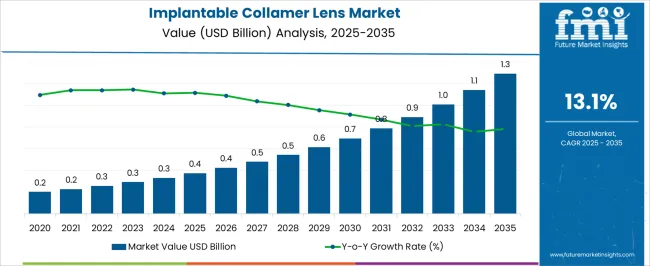
| Metric | Value |
|---|---|
| Implantable Collamer Lens Market Estimated Value in (2025 E) | USD 0.4 billion |
| Implantable Collamer Lens Market Forecast Value in (2035 F) | USD 1.3 billion |
| Forecast CAGR (2025 to 2035) | 13.1% |
The implantable collamer lens (ICL) market is expanding steadily, driven by the rising prevalence of refractive errors and growing demand for advanced vision correction alternatives beyond traditional spectacles and contact lenses. Clinical publications and ophthalmology society reports have emphasized the effectiveness of ICLs in addressing high myopia and other complex refractive conditions where laser-based corrections may not be suitable. Increased awareness among patients about long-term visual outcomes, coupled with shorter recovery times and reversibility of the procedure, has supported adoption rates.
Investor presentations and company press releases have highlighted significant investments in product innovation, particularly lenses with advanced optical designs, smaller incision requirements, and enhanced biocompatibility. Additionally, increasing procedural volumes in emerging economies, supported by rising disposable incomes and expanding healthcare infrastructure, have broadened market access.
Regulatory approvals for next-generation ICLs and expanding clinical training programs for ophthalmologists are further accelerating adoption. Looking forward, the market is expected to benefit from technological refinements, rising surgical expertise, and growing patient preference for minimally invasive, high-precision vision correction solutions.
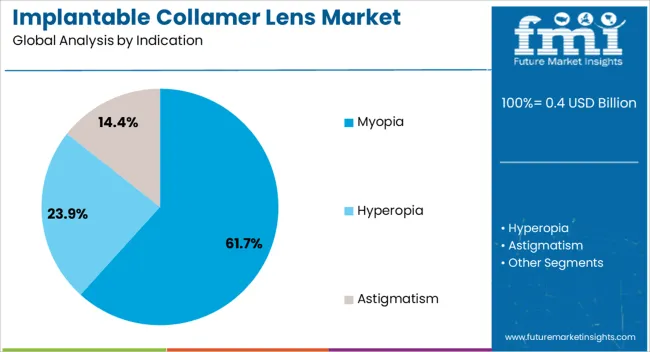
The Myopia segment is projected to account for 61.7% of the implantable collamer lens market revenue in 2025, establishing itself as the leading indication. This dominance has been supported by the global surge in myopia prevalence, particularly in younger populations and urbanized regions with high digital device usage. Clinical evidence has shown that ICLs provide superior correction for moderate-to-high myopia compared to conventional refractive surgeries, delivering stable outcomes without significant corneal tissue removal.
Ophthalmologists have increasingly recommended ICLs for patients unsuitable for LASIK or PRK due to thin corneas or high refractive errors. Industry updates have further pointed to product advancements, such as toric ICLs for patients with concurrent astigmatism, which have expanded clinical indications.
With lifestyle factors accelerating myopia incidence and growing patient preference for premium vision correction options, the Myopia segment is expected to sustain its leading market share.
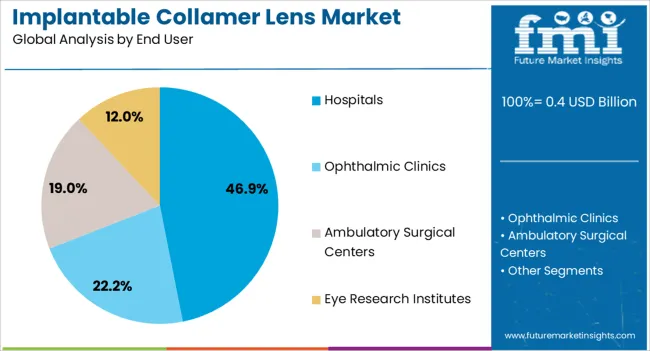
The Hospitals segment is projected to hold 46.9% of the implantable collamer lens market revenue in 2025, retaining its leading role among end users. This segment’s growth has been supported by the availability of advanced surgical infrastructure, specialized ophthalmic surgeons, and comprehensive post-operative care facilities. Hospitals have been at the forefront of adopting new ICL technologies, facilitated by their ability to manage complex procedures and handle high patient volumes.
Press releases and clinical updates have underscored that hospitals benefit from broader access to supplier partnerships, training programs, and regulatory-compliant equipment, ensuring standardized treatment outcomes. Additionally, hospitals have gained patient trust as centers capable of delivering safe and effective surgical experiences, particularly in regions where specialized ophthalmic clinics remain limited.
The integration of ophthalmology departments within multispecialty hospitals has further enhanced access to ICL procedures, supporting the segment’s sustained leadership. As demand for refractive surgeries continues to rise, hospitals are expected to remain the primary channel for implantable collamer lens adoption.
An implantable collamer lens consists of a specially engineered biomaterial called Collamer that is biocompatible and safe. Implantable collamer lenses will remain in place for the long term, thus removing the need for glasses or contacts for long periods. From 2020 to 2025, a CAGR of 22.7% was recorded in the implantable implantable collamer lens market.
As awareness and access to ICL surgery are increased, this vision correction option is likely to become more popular. ICLs are set to become increasingly popular as people become aware of their advantages, even if they cannot qualify for traditional laser vision correction procedures.
The market for these lenses is expected to grow in the future as long as regulatory approvals continue and ICL technology advances. In the future, there are anticipated to be new models and indication ICL devices approved, with new manufacturers entering the market. This will provide patients with a greater variety of options. Based on the projections, the CAGR is expected to reach 13.2% between 2025 and 2035.
| Historical CAGR from 2020 to 2025 | 22.7% |
|---|---|
| Forecast CAGR from 2025 to 2035 | 13.2% |
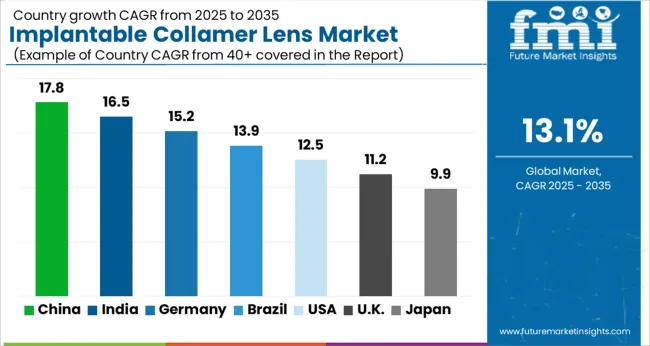
Regional variations in ICL adoption can be seen in the table below giving an overview of how the market is trending in each of the countries. Major ICL manufacturers in many countries focus on high-quality materials and integrated technologies.
Forecasts indicate growth in United States, Spain, Germany, Italy and the United Kingdom. On a global scale, North America is expected to become a key industry. The next largest market is Southern Europe, followed by the rest of the world. The economic growth of emerging economies is creating new markets for ICLs.
Forecast CAGRs from 2025 to 2035
| Countries | Value CAGR |
|---|---|
| The United States | 19.8% |
| United Kingdom | 12.8% |
| Germany | 14.8% |
| Italy | 15.5% |
| Spain | 17.5% |
ICLs, or implantable collamer lenses, are becoming one of the most popular vision correction options in the United States. Technological advancement and minimally invasive surgeries to create a market for ICL’s in United States.
The market is forecast to expand at a CAGR of 19.8% over the next few decades. As more patients seek long-term vision correction solutions, ICLs are steadily gaining in popularity in the United States.
In the wake of advances in technology and better surgical techniques, ICLs have become a good option for people looking to improve their quality of life.
ICLs are increasingly being adopted in the United Kingdom as more people seek advanced vision solutions. ICLs are poised for mainstream adoption in the United Kingdom, as surgical techniques and awareness continue to advance. United Kingdom will contribute 12.8% CAGR during the next ten years.
Reimbursement policies by insurance companies for ICL implantation surgery to drive demand in next few years. A growing amount of medical tourism in the country will likely boost sales of implantable collamer lenses in the coming years. Increasing infrastructure development and high quality practitioners will drive the demand for the market.
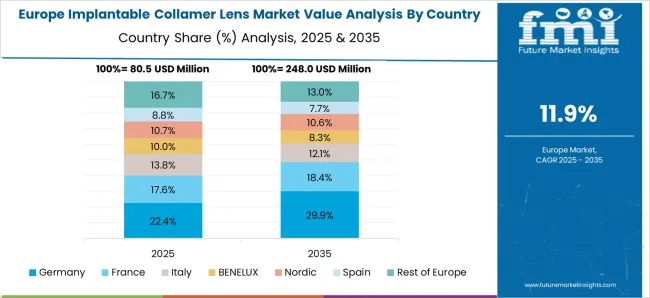
Germany is anticipated to expand at a CAGR of 14.8% during the forecast period. The market for pain-free procedures is experiencing a surge in popularity among consumers who are becoming aware of the benefits. Regulations on the safety and efficacy of ICLs, impacting market approval processes are expected to play a major role.
Stringent quality control and sterilization standards for ICL manufacturing is expected to boost the market. In June 2025, the German Commission on Refractive Surgery (KRC) will released its guidelines for ICL implantation, including guidelines for myopia and astigmatism between 1.0 D and +1.0 D. Regulations on product liability for medical devices like ICLs are expected to increase demand.
Among the options available for achieving youthful and natural vision, implantable collamer lenses have grown in popularity in Spain over the past few years. In addition to offering clear vision, ICLs preserve the aesthetics and integrity of the eye as they do not alter the natural curvature of the cornea. They are particularly popular among women who value beauty and vitality.
The combination of vision correction and youthful appearance is particularly appealing to those who are searching for vision correction solutions. In addition to enjoying crisp, natural vision, people in Spain can also enjoy outstanding comfort and aesthetics with ICLs. A 17.5% CAGR is forecasted for Spain between 2025 and 2035.
With an appreciation for craftsmanship and meticulousness, implantable collamer lenses are highly valued in Italy. ICLs offer tailor-made correction with unique visual needs, as they value aesthetics and design. Rising disposable income and increasing patient demand for elective vision correction procedures to expand the market.
The market for implantable collamer lenses in Italy is expected to expand at a CAGR of 15.5%. ICLs offer precise and customized correction for refractive errors, including astigmatism and high myopia, in a world where high-quality vision enhancement options are highly sought-after.
Detailed information about the leading segment can be found in the following section. Based on the end user, the hospital segment held 52.4% market share in 2025. Based on indication, the myopia segment accounted for a market share of 78.2% in 2025.
| Category | Market Share 2025 |
|---|---|
| Myopia | 78.2% |
| Hospital | 52.4% |
Based on indications, myopia is likely to show prominent growth for implantable collamer lenses in the market. Across the globe, eye health problems like myopia are on the rise, along with glaucoma, cataracts, and retinal damage.
As myopia prevalence increases, implantable collamer lenses (ICLs) are expected to become more popular as a treatment option. As ICLs grow in popularity, innovations in their materials, designs, and applications can contribute to their predictability, efficacy, and safety.
Innovators are developing new products like the EVO Visian ICL for correcting super-high myopia, which will increase demand for ICLs.
Based on end users, the hospital segment is likely to grow the demand for ICL. Assuring the safety and control of ICL surgeries, hospitals provide the necessary infrastructure and facilities.
After surgery, hospitals monitor the patients' progress as part of following up with them and performing regular checks to ensure the ICL is functioning properly. The hospital plays an important role in informing patients about the advantages, dangers, and potential side effects of ICL surgery. In order to make informed decisions, they provide patients with information.
Support and guidance are provided by hospitals in the case of difficulties or post-surgery symptoms such as pressure, blurred vision, or possible infection indicators.
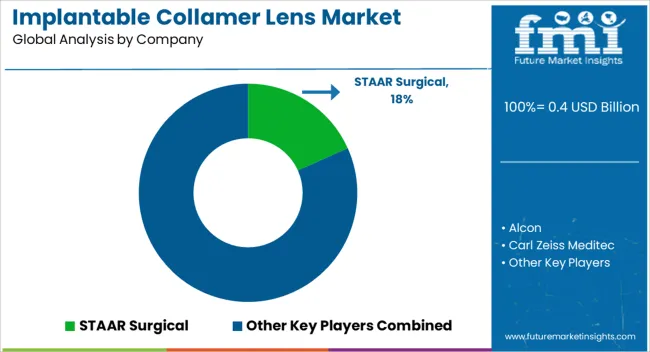
A highly competitive environment fosters innovation, with companies concentrating their efforts on advanced lens materials, and customized designs. Strategies for new entrants to focus on niche markets. Mergers and acquisitions in the ICL market to expand the market further.
Some of the key developments are:
| Attributes | Details |
|---|---|
| Estimated Market Size in 2025 | USD 330.5 million |
| Projected Market Valuation in 2035 | USD 1,141.80 million |
| Value-based CAGR 2025 to 2035 | 13.2% |
| Forecast Period | 2025 to 2035 |
| Historical Data Available for | 2020 to 2025 |
| Market Analysis | Value in USD million |
| Key Regions Covered | North America; Latin America; Western Europe; Eastern Europe; South Asia; East Asia; The Middle East and Africa |
| Key Market Segments Covered | Indication, End User, Region |
| Key Countries Profiled | The United States, Canada, Brazil, Mexico, Germany, United Kingdom, France, Spain, Italy, Poland, Russia, Czech Republic, Romania, India, Bangladesh, Australia, New Zealand, China, Japan, South Korea, GCC Countries, South Africa, Israel |
| Key Companies Profiled | STAAR Surgical; Alcon; Carl Zeiss Meditec; Johnson & Johnson; Bausch +Lomb |
The market is classified into Myopia, Hyperopia and Astigmatism.
The report consists of key sourcing such as hospitals, ophthalmic clinics, ambulatory surgical centers, eye research institutes.
Analysis of the market has been undertaken in major markets of North America, Latin America, Western Europe, South Asia, East Asia, Eastern Europe, and Middle East & Africa.
The global implantable collamer lens market is estimated to be valued at USD 0.4 billion in 2025.
The market size for the implantable collamer lens market is projected to reach USD 1.3 billion by 2035.
The implantable collamer lens market is expected to grow at a 13.1% CAGR between 2025 and 2035.
The key product types in implantable collamer lens market are myopia, hyperopia and astigmatism.
In terms of end user, hospitals segment to command 46.9% share in the implantable collamer lens market in 2025.






Full Research Suite comprises of:
Market outlook & trends analysis
Interviews & case studies
Strategic recommendations
Vendor profiles & capabilities analysis
5-year forecasts
8 regions and 60+ country-level data splits
Market segment data splits
12 months of continuous data updates
DELIVERED AS:
PDF EXCEL ONLINE
Implantable Defibrillator Market Size and Share Forecast Outlook 2025 to 2035
Implantable Infusion Pump Market Size and Share Forecast Outlook 2025 to 2035
Implantable Drug Eluting Devices Market Size and Share Forecast Outlook 2025 to 2035
Implantable Drug Infusion Pumps Market
Subcutaneous Implantable Defibrillator System Market Size and Share Forecast Outlook 2025 to 2035
Subcutaneous Implantable Defibrillator (S-ICD) Market is segmented by product, indication, and end user from 2025 to 2035
Camera Lens Market Size and Share Forecast Outlook 2025 to 2035
Contact Lens Inspection Equipment Market Size and Share Forecast Outlook 2025 to 2035
Optical Lens Materials Market Size and Share Forecast Outlook 2025 to 2035
Contact Lens Industry Analysis in GCC Size and Share Forecast Outlook 2025 to 2035
Scleral Lenses Market Size and Share Forecast Outlook 2025 to 2035
Contact Lenses Market – Trends, Growth & Forecast 2025 to 2035
Contact Lens Solution Market Analysis by Product Type, Volume, Purpose, Distribution Channel, and Region through 2035
Global Contact-lens Induced Infections Market Analysis – Size, Share & Forecast 2024-2034
Acrylic Lenses Market
Anti-Fog Lens Market Insights - Size, Trends & Forecast 2025 to 2035
Global Spectacle Lens Market Analysis – Size, Share & Forecast 2024-2034
Aspherical Lens Market Size and Share Forecast Outlook 2025 to 2035
Intraocular Lens Market Size and Share Forecast Outlook 2025 to 2035
Collimating Lens Market – Growth & Technology Trends 2025 to 2035

Thank you!
You will receive an email from our Business Development Manager. Please be sure to check your SPAM/JUNK folder too.
Chat With
MaRIA